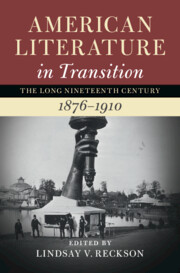Book contents
- American Literature in Transition, 1876–1910
- Nineteenth-Century American Literature in Transition
- American Literature in Transition, 1876–1910
- Copyright page
- Contents
- Contributors
- Series Preface
- Acknowledgments
- Chronology
- Introduction
- Part I Transitive States
- Part II Post-Reconstruction Aesthetics
- Chapter 6 Lyrics of the Color Line
- Chapter 7 Experimental Realisms
- Chapter 8 Species of Sentiment
- Chapter 9 The Microclimates of Regionalism
- Chapter 10 Racial Topographies and the Poetics of Mass Culture
- Part III Old Materialisms
- Part IV Immanent Techniques
- Index
Chapter 8 - Species of Sentiment
from Part II - Post-Reconstruction Aesthetics
Published online by Cambridge University Press: 24 August 2022
- American Literature in Transition, 1876–1910
- Nineteenth-Century American Literature in Transition
- American Literature in Transition, 1876–1910
- Copyright page
- Contents
- Contributors
- Series Preface
- Acknowledgments
- Chronology
- Introduction
- Part I Transitive States
- Part II Post-Reconstruction Aesthetics
- Chapter 6 Lyrics of the Color Line
- Chapter 7 Experimental Realisms
- Chapter 8 Species of Sentiment
- Chapter 9 The Microclimates of Regionalism
- Chapter 10 Racial Topographies and the Poetics of Mass Culture
- Part III Old Materialisms
- Part IV Immanent Techniques
- Index
Summary
Post-Reconstruction sentimentalism is generally narrated as a story of decline – from a high point of cultural and literary authority in the early nineteenth century to a waning presence in the interwar years. Yet, as I demonstrate in this chapter, turn-of-the-century America turned sentiment into a science of feeling. I begin by delineating the sentimental elements of period science and, in particular, the gendered, racialized models of human feeling that circulate in evolutionary biology and New Psychology, two of the post-Reconstruction era’s emergent scientific discourses. I then look at the scientific elements of the period’s sentimental literary aesthetics. Scholars have long identified the sentimentalism of fiction by writers like Kate Chopin, Theodore Dreiser, Henry James, Frank Norris, and Edith Wharton as distinct from the scientific interests of evolving modes of realism, naturalism, and modernism. In this body of work, sentimental aesthetics – conventions of plot and character, formal techniques, tonal qualities, and other stylistic choices – supposedly occur as atavistic characteristics: recurrences of an historical sensibility and an established artistic tradition immune to the sea change in modern letters. This chapter reframes these perceptions of cultural and aesthetic progress. Focusing on Wharton’s The House of Mirth (1905), I argue that turn-of-the-century US writers reinvented sentimentalism in dialogue with developing clinical notions of selfhood.
- Type
- Chapter
- Information
- American Literature in Transition, 1876–1910 , pp. 161 - 181Publisher: Cambridge University PressPrint publication year: 2022



